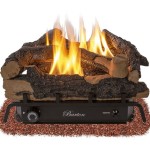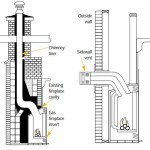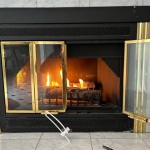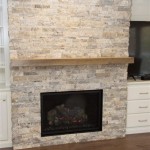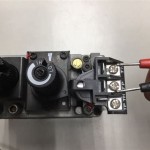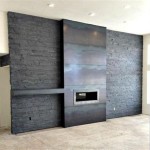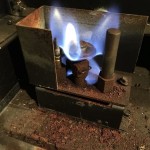TV Hole Above Fireplace: Examining Functionality, Aesthetics, and Safety
The placement of a television above a fireplace has become a common design choice in contemporary homes. While aesthetically appealing to some, this configuration presents several considerations regarding functionality, aesthetics, and, most importantly, safety. The decision to install a television above a fireplace should be carefully weighed, taking into account the potential drawbacks and necessary precautions to ensure both optimal viewing experience and the longevity of the electronic device.
Often, the rationale behind this arrangement revolves around maximizing space, particularly in smaller living rooms where wall space is limited. Centering both the fireplace and television on the same wall aims to create a focal point, unifying the room's design. However, this approach necessitates a comprehensive understanding of the technical and practical implications that arise from combining heat sources and sensitive electronic equipment.
Understanding Heat's Impact on Television Lifespan
One of the most significant concerns regarding a television above a fireplace is the potential damage caused by heat exposure. Electronic components within a television are designed to operate within a specific temperature range. Exceeding this range, even over extended periods, can lead to premature failure, reduced performance, and ultimately, a significantly shortened lifespan for the device. The heat generated by a fireplace, whether gas, electric, or wood-burning, rises directly upwards, exposing the television to consistent warmth, which can degrade the internal components. This heat can affect everyting from the LCD panel to the sensitive circuit boards leading to visible degradation of the picture quality such as "clouding" or "lines appearing".
The extent of heat exposure depends on several factors, including the type of fireplace, its frequency of use, the distance between the fireplace and the television, and the presence of a mantel. Mantels act as a protective shield, deflecting heat away from the television. However, even with a mantel, prolonged and frequent use of the fireplace can still subject the television to elevated temperatures. It's important to observe how much heat is being generated, if safe to do so, by holding your hand at where the TV would be and see if you can comfortably leave it there for longer than 30 seconds.
Furthermore, improper ventilation around the television can exacerbate the issue. Televisions generate their own heat during operation. If the area behind the television is enclosed or poorly ventilated, the heat from the fireplace can combine with the television's internal heat, creating a potentially damaging environment. This lack of air circulation can trap heat close to the body of the TV and damage the components. Adequate spacing around the television and the use of ventilation systems may mitigate these risks.
Ergonomics and Optimal Viewing Angle
Beyond the potential for heat damage, the placement of a television above a fireplace often results in a suboptimal viewing experience. The ideal viewing angle for a television is generally considered to be at eye level when seated. Placing the television significantly higher, as is often the case above a fireplace, forces viewers to tilt their heads upwards, leading to neck strain and discomfort during prolonged viewing sessions. This is especially pronounced for individuals who spend extended periods watching television.
The viewing distance also plays a crucial role. A television placed high above a fireplace may necessitate a greater viewing distance to maintain a comfortable perspective. However, not all living rooms can accommodate such a distance. A smaller room, combined with an elevated television, can create a distorted viewing experience, making it difficult to focus on the screen and appreciate the picture quality. This is especially apparent on larger screens.
Solutions to mitigate these ergonomic issues include using a tilting television mount that allows viewers to adjust the angle of the screen downwards. However, tilting the television can also distort the image, depending on the viewing angle. The best compromise may be to not elevate the television more than 12 inches above the eye line when sitting.
Aesthetic Considerations and Design Harmony
While the appeal of a centralized focal point is understandable, a television above a fireplace can sometimes create an unbalanced or cluttered aesthetic. The combination of two visually dominant elements – a fireplace and a large screen television – may overwhelm the room's design, particularly in smaller spaces. The dark rectangle of the TV can stand out from the fireplace, creating a "black hole" effect which draws the eye despite there being no content to see.
Integrating the television seamlessly into the surrounding décor requires careful planning. Concealing the television when not in use can be a solution. Retractable screens, sliding panels, or even mirrored surfaces can effectively hide the television, allowing the fireplace to take center stage when desired. Other times this area can be decorated with plants or photographs to soften the effect of a black screen. The key is to create a harmonious balance between the two elements, preventing either from dominating the visual space.
Cable management is another crucial aesthetic consideration. Exposed cables detract from the overall appearance and can create a visually chaotic environment. Concealing cables within the wall or using cable management systems helps maintain a clean and organized look. The use of products such as cable concealer strips can provide the appearance of a clean and modern setup. Wireless HDMI transmitters can also be used in specific situations but should be investigated thoroughly for reliability.
Ultimately, the decision to place a television above a fireplace is a personal one, influenced by individual preferences and design priorities. However, a thorough understanding of the potential drawbacks, coupled with appropriate safety measures and ergonomic adjustments, is essential for creating a functional, aesthetically pleasing, and safe living space.

Before After Mantel Covering The Tv Niche Above Fireplace Inspired Room Makeover Over

What Is The Best Way To Deal With An Tv Hole Above Fire Place Hometalk

Need Help Best Options For Covering Up Old Tv Hole Above Mantle

Tv Hole Above Fireplace Google Search Home House Inspiration

Before After Mantel Covering The Tv Niche Above Fireplace Inspired Room

Before After Mantel Covering The Tv Niche Above Fireplace Inspired Room

My Story How I Eliminated Tv Niche Above The Fireplace Over

Building A Fireplace Mantel After Closing Tv Niche Above Hometalk

How To Cover A Tv Niche With Chalkboard

Edited Not To Be Confused With The New Posts This Diy Project Was Done In Our Old House Many Years Ago Back 200 Tv Niche Home Fireplace Above

